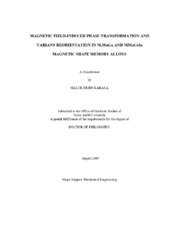| dc.contributor.advisor | Karaman, Ibrahim | |
| dc.creator | Karaca, Haluk Ersin | |
| dc.date.accessioned | 2010-01-14T23:58:45Z | |
| dc.date.accessioned | 2010-01-16T01:55:31Z | |
| dc.date.available | 2010-01-14T23:58:45Z | |
| dc.date.available | 2010-01-16T01:55:31Z | |
| dc.date.created | 2007-08 | |
| dc.date.issued | 2009-05-15 | |
| dc.identifier.uri | https://hdl.handle.net/1969.1/ETD-TAMU-1562 | |
| dc.description.abstract | The purpose of this work is to reveal the governing mechanisms responsible for the magnetic field-induced i) martensite reorientation in Ni2MnGa single crystals, ii) stress-assisted phase transformation in Ni2MnGa single crystals and iii) phase transformation in NiMnCoIn alloys. The ultimate goal of utilizing these mechanisms is to increase the actuation stress levels in magnetic shape memory alloys (MSMAs). Extensive experimental work on magneto-thermo-mechanical (MTM) characterization of these materials enabled us to i) better understand the ways to increase the actuation stress and strain and decrease the required magnetic field for actuation in MSMAs, ii) determine the effects of main MTM parameters on reversible magnetic field induced phase transformation, such as magnetocrystalline anisotropy energy (MAE), Zeeman energy (ZE), stress hysteresis, thermal hysteresis, critical stress for the stress induced phase transformation and crystal orientation, iii) find out the feasibility of employing polycrystal MSMAs, and iv) formulate a thermodynamical framework to capture the energetics of magnetic field-induced phase transformations in MSMAs. Magnetic shape memory properties of Ni2MnGa single crystals were characterized by monitoring magnetic field-induced strain (MFIS) as a function of compressive stress and stress-induced strain as a function of magnetic field. It is revealed that the selection of the operating temperature with respect to martensite start and Curie temperatures is critical in optimizing actuator performance. The actuation stress of 5 MPa and work output of 157 kJm−3 are obtained by the field-induced variant reorientation in NiMnGa alloys. Reversible and one-way stress-assisted field-induced phase transformations are observed in Ni2MnGa single crystals under low field magnitudes (<0.7T) and resulted in at least an order of magnitude higher actuation stress levels. It is very promising to provide higher work output levels and operating temperatures than variant reorientation mechanisms in NiMnGa alloys. Reversible field-induced phase transformation and shape memory characteristics of NiMnCoIn single crystals are also studied. Reversible field-induced phase transformation is observed only under high magnetic fields (>4T). Necessary magnetic and mechanical conditions, and materials design and selection guidelines are proposed to search for field-induced phase transformation in other ferromagnetic materials that undergo thermoelastic martensitic phase transformation. | en |
| dc.format.medium | electronic | en |
| dc.format.mimetype | application/pdf | |
| dc.language.iso | en_US | |
| dc.subject | magnetic shape memory alloys | en |
| dc.subject | ferromagnetic shape memory alloys | en |
| dc.subject | phase transformation | en |
| dc.subject | martensitic transformation | en |
| dc.subject | variant reorientation | en |
| dc.subject | magnetocrystalline anisotropy energy | en |
| dc.title | Magnetic field-induced phase transformation and variant reorientation in Ni2MnGa and NiMnCoIn magnetic shape memory alloys | en |
| dc.type | Book | en |
| dc.type | Thesis | en |
| thesis.degree.department | Mechanical Engineering | en |
| thesis.degree.discipline | Mechanical Engineering | en |
| thesis.degree.grantor | Texas A&M University | en |
| thesis.degree.name | Doctor of Philosophy | en |
| thesis.degree.level | Doctoral | en |
| dc.contributor.committeeMember | Hartwig, Karl Ted | |
| dc.contributor.committeeMember | Lagoudas, Dimitris C | |
| dc.contributor.committeeMember | Zhang, Xinghang | |
| dc.type.genre | Electronic Dissertation | en |
| dc.type.material | text | en |
| dc.format.digitalOrigin | born digital | en |


